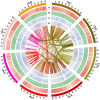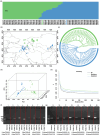The chromosome-level assembly of the wild diploid alfalfa genome provides insights into the full landscape of genomic variations between cultivated and wild alfalfa
- PMID: 38288521
- PMCID: PMC11123407
- DOI: 10.1111/pbi.14300
The chromosome-level assembly of the wild diploid alfalfa genome provides insights into the full landscape of genomic variations between cultivated and wild alfalfa
Abstract
Alfalfa (Medicago sativa L.) is one of the most important forage legumes in the world, including autotetraploid (M. sativa ssp. sativa) and diploid alfalfa (M. sativa ssp. caerulea, progenitor of autotetraploid alfalfa). Here, we reported a high-quality genome of ZW0012 (diploid alfalfa, 769 Mb, contig N50 = 5.5 Mb), which was grouped into the Northern group in population structure analysis, suggesting that our genome assembly filled a major gap among the members of M. sativa complex. During polyploidization, large phenotypic differences occurred between diploids and tetraploids, and the genetic information underlying its massive phenotypic variations remains largely unexplored. Extensive structural variations (SVs) were identified between ZW0012 and XinJiangDaYe (an autotetraploid alfalfa with released genome). We identified 71 ZW0012-specific PAV genes and 1296 XinJiangDaYe-specific PAV genes, mainly involved in defence response, cell growth, and photosynthesis. We have verified the positive roles of MsNCR1 (a XinJiangDaYe-specific PAV gene) in nodulation using an Agrobacterium rhizobia-mediated transgenic method. We also demonstrated that MsSKIP23_1 and MsFBL23_1 (two XinJiangDaYe-specific PAV genes) regulated leaf size by transient overexpression and virus-induced gene silencing analysis. Our study provides a high-quality reference genome of an important diploid alfalfa germplasm and a valuable resource of variation landscape between diploid and autotetraploid, which will facilitate the functional gene discovery and molecular-based breeding for the cultivars in the future.
Keywords: alfalfa; genome assembly; nodule‐specific cysteine‐rich peptides; population structure; structural variants.
© 2024 The Authors. Plant Biotechnology Journal published by Society for Experimental Biology and The Association of Applied Biologists and John Wiley & Sons Ltd.
Conflict of interest statement
The authors declare no conflicts of interest.
Figures







References
-
- Allario, T. , Brumos, J. , Colmenero‐Flores, J.M. , Iglesias, D.J. , Pina, J.A. , Navarro, L. , Talon, M. et al. (2013) Tetraploid Rangpur lime rootstock increases drought tolerance via enhanced constitutive root abscisic acid production. Plant Cell Environ. 36, 856–868. - PubMed
MeSH terms
Grants and funding
LinkOut - more resources
Full Text Sources
Miscellaneous

